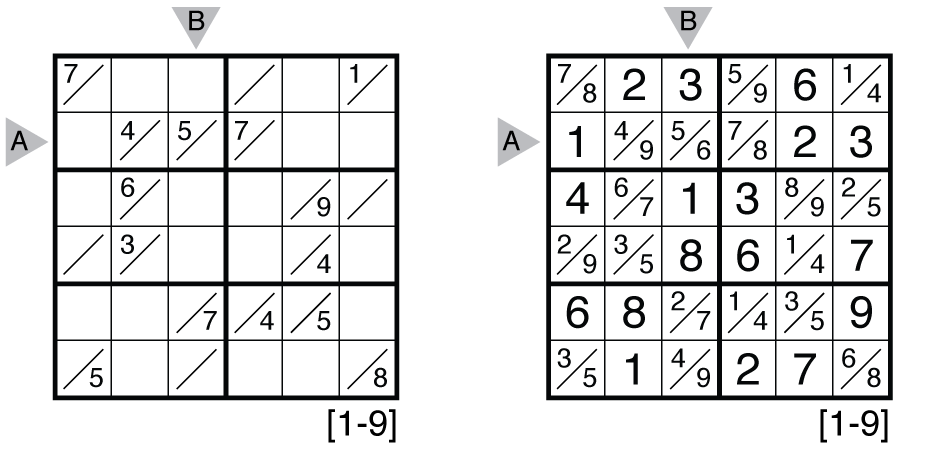Tight Fit Sudoku R&I

Rules: Standard Sudoku rules (insert a number in the indicated range into each cell so that no number repeats in any row, column, or bold region). Some cells are split by slashes; in these cells the smaller number must go above the larger number.
Answer String: Enter the row/column marked “A”, followed by a comma, followed by the row/column marked “B”. Rows are entered from left to right and columns from top to bottom. This example has the key “149567823,356182749”.
(Brief) History of Tight Fit Sudoku: Descended from Sudoku. The idea was first developed by Thomas Snyder for his book Mutant Sudoku, inspired by a playoff puzzle that almost appeared at the second World Sudoku Championship in Prague.
History of this example: This Tight Fit Sudoku was written by Thomas Snyder for the 2009 Czech Sudoku Championship.
Sources for Tight Fit Sudoku: Follow this link for Tight Fit Sudoku puzzles on this website. If you are new to this puzzle type, here are our easiest Tight Fit Sudoku to get started on. More Tight Fit Sudoku puzzles can be found in our beginner-friendly collection Intro to GMPuzzles by Serkan Yürekli, in The Art of Sudoku 2, and in Masterpiece Sudoku Mix 5: Tight Fit Sudoku. Other sources (some potentially now out of print) are Mutant Sudoku and the Sit and Solve title Tight Fit Sudoku both from Sterling/Puzzlewright.
Design rules for contributors: A Grandmaster Tight Fit Sudoku will have a unique solution that can be reached by logic alone. Generally, a Grandmaster Tight Fit Sudoku has a symmetric layout of slashed cells, and a symmetric or pseudo-symmetric layout of givens, meaning that the same tight fit cells may contain givens but they could all be “tops” and not have to be rotationally symmetric. Ranges from 1-7 to 1-12 are allowed in the standard 6×6 form.

I’m presuming the Prague variation was “0-9 Sudoku?” There’s also an example of one of those in Round 5 of the 2006 WSC in Lucca. For the benefit of your readers, there are two main differences between tight fit and 0-9 despite looking very similar at first glance.
Firstly, 0-9 lives in a much large 9×9 grid and necessarily has one cell per row/column/box being split. Secondly, there is no restriction that the top half should contain a smaller number than the bottom half.
The second constraint especially means that in my opinion tight fit are generally more pleasant to solve!
No. There was a playoff puzzle announced with 1-12 in a 6×6 grid. It apparently did not show up well on camera so was not used. I would gladly see 0-9 Sudoku use this concept.